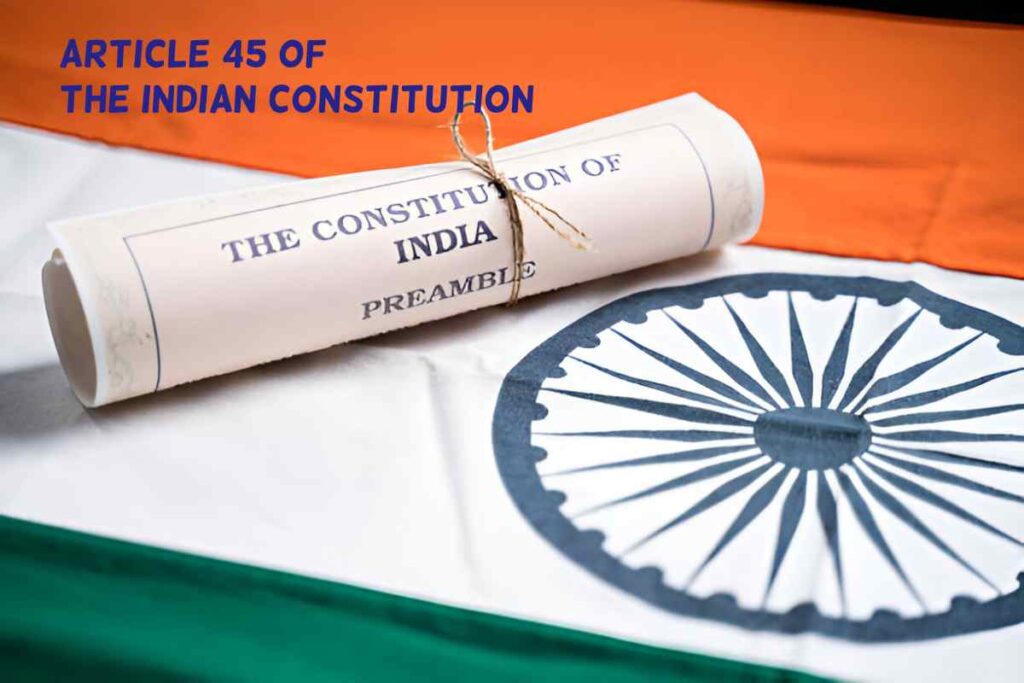The free and compulsory education of necessary education is provided under Article 45 of the Constitution of India. For any society to be considered developed, education is paramount. It makes it possible for people to be satisfied and remain functional in their daily responsibilities. But let me assure you that due to one reason or another, including poverty, early marriage, and gender discrimination. Among other things, millions of children of school-going age are out of school in India.
This major problem was sought to be redressed with the help of Article 45 of the Indian Constitution, which said that education must be provided and made available to all children. But before we get there, let me explain this article and why it is so significant. Alright, let’s provide some deeper analysis.
The Following Is The Provision Of Article 45 of the Indian Constitution
As pointed out, Article 45 is under the Directive Principles of State Policy section of the Constitution of India. It says:
” The State shall, within ten years of the coming into operation of this Constitution. Arrange free and compulsory education of all children until they reach 14 years.”
In Simple Terms, This Means
- But the government should try to ensure free and compulsory education for all children in India under the age of fourteen years.
- It was achieved ten years after the constitution’s passing, which was expected to be by 1960.
The article admits that it is indeed possible to educate a nation’s children, which is crucial for its success. Therefore, it can make primary education one of the state’s fundamental human rights and constitutional responsibilities.
Article 45 of the Indian Constitution: Why Is It Relevant for India?
When the Constitution of India was framed in the year 1950, the literacy rate in the country was a mere 18%. Lack of education was due to factors such as poverty and socio-economic status. Article 45 was thus pivotal because it:
- Provides Equal Opportunities: Education makes individuals capable and ensures that one can achieve a higher social class irrespective of their status at birth. According to the provision in Article 45, there is a right to equal educational opportunities.
- Uplifts Weaker Sections: It compels the state to ensure that all children, even those in the streets and who are so poor, are provided with educational materials, hence improving the living standards of society.
- Drives National Development: Education enables the youths to afford the country’s economic needs. Universal literacy is critical to the development of any country because it causes fast development.
- Promotes Individual Growth: Education creates mental abilities and capacities like reasoning power, judgment, spirit of inquiry, and many others. Article 45 is also a good one that assists children to attain their maximum potential.
Though the target of achieving the objective in ten years was unattainable, the article sure put pressure on policymakers to keep trying for this goal.
Measures Taken to Cue Article 45 of the Indian Constitution
It becomes an issue when free and compulsory education is available to all children. The following are some of the efforts that have been made after the adoption of Article 45:
-
- In 1968, the National Policy on Education was framed to increase the facilities of Early education and lay stress on higher education.
- It concludes the 86th Constitutional Amendment in 2002, which comprises Article 21A, the right to free education for children aged 6-14.
- In 2001, the government of India initiated the education for All Campaign or SSA. Intending to put all the children in the age group of 6-14 years in elementary Education schools.
-
- Elaborated in Article 21A of the Indian Constitution, the Rights to Education (RTE) Act 2009 defines the specific functions of the Centre and the States in extending free education.
These measures contributed to enhancing the literacy rates among the youths in India. Which is estimated to be approximately 90% in 2020. However, there is still an opportunity to increase the indicators of enrollment rates, retention rates after primary education, and learning achievement indicators.
Conclusion
Though the goal of universal elementary education is still elusive even today. Article 45 planted the seed during the very formation of the Indian Constitution by making it a directive principle of state policy. It also helped strengthen the role of education in the development of the child. As well as in the preparation for life responsibilities and the advancement of the nation.
These efforts under Article 45 grew through significant policies and initiatives. The table below shows major policies and initiatives that supported efforts under Article 45. However, with India still needing to do more for the education of its children, there is now an acknowledgment that education is a fundamental human right.
In the future, adequate funds, development partnerships, the improvement of the infrastructure of rural schools. Learning achievement can support Article 45’s goal of educating children to Become equipped for valuable citizenship in India.






